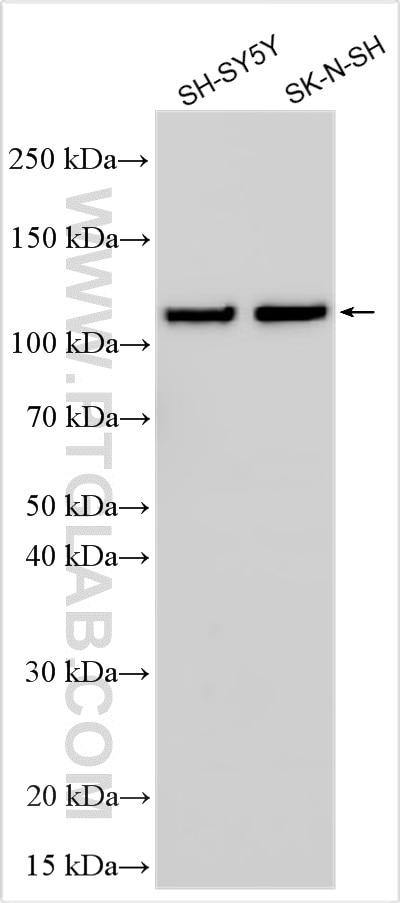Tested Applications
| Positive WB detected in | SH-SY5Y cells, SK-N-SH cells |
Recommended dilution
| Application | Dilution |
|---|---|
| Western Blot (WB) | WB : 1:500-1:2000 |
| It is recommended that this reagent should be titrated in each testing system to obtain optimal results. | |
| Sample-dependent, Check data in validation data gallery. | |
Product Information
21762-1-AP targets EPHB1 in WB, ELISA applications and shows reactivity with human, mouse, rat samples.
| Tested Reactivity | human, mouse, rat |
| Host / Isotype | Rabbit / IgG |
| Class | Polyclonal |
| Type | Antibody |
| Immunogen | EPHB1 fusion protein Ag16347 Predict reactive species |
| Full Name | EPH receptor B1 |
| Calculated Molecular Weight | 984 aa, 110 kDa |
| Observed Molecular Weight | 110-120 kDa |
| GenBank Accession Number | BC111744 |
| Gene Symbol | EPHB1 |
| Gene ID (NCBI) | 2047 |
| Conjugate | Unconjugated |
| Form | Liquid |
| Purification Method | Antigen affinity purification |
| UNIPROT ID | P54762 |
| Storage Buffer | PBS with 0.02% sodium azide and 50% glycerol, pH 7.3. |
| Storage Conditions | Store at -20°C. Stable for one year after shipment. Aliquoting is unnecessary for -20oC storage. 20ul sizes contain 0.1% BSA. |
Background Information
EPHB1, also named as EPHT2, NET, HEK6 and ELK, belongs to the protein kinase superfamily, Tyr protein kinase family, and Ephrin receptor subfamily. It is a receptor for members of the ephrin-B family. EPHB1 binds to ephrin-B1, -B2 and -B3. EPHB1 may be involved in cell-cell interactions in the nervous system. EPHB1 catalyzes the reaction: ATP + a [protein]-L-tyrosine = ADP + a [protein]-L-tyrosine phosphate.
Protocols
| Product Specific Protocols | |
|---|---|
| WB protocol for EPHB1 antibody 21762-1-AP | Download protocol |
| Standard Protocols | |
|---|---|
| Click here to view our Standard Protocols |



